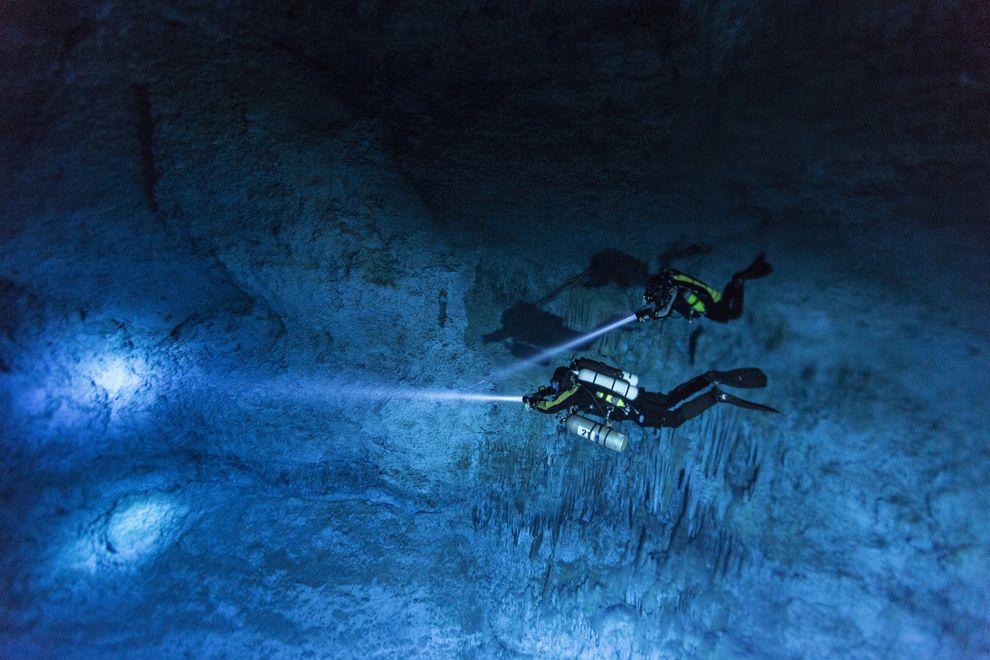It looks like you're using an Ad Blocker.
Please white-list or disable AboveTopSecret.com in your ad-blocking tool.
Thank you.
Some features of ATS will be disabled while you continue to use an ad-blocker.
10
share:
On Thursday, a team led by archaeologist James Chatters reported in the journal Science that they'd found a big piece of the puzzle: the most complete skeleton of such antiquity ever found in the Americas, between 12,000 and 13,000 years old. The skeleton contains both the craniofacial features of ancient Paleoamericans and mitochondrial DNA possessed by latter-day Native Americans.
he skeleton, dubbed "Naia" (an ancient Greek name related to water nymphs) by her discoverers, belonged to a teenage girl who fell more than 100 feet to her death nearly a half mile inside an elaborate network of karst caves that were largely dry at the end of the Pleistocene. Divers who found Naia in the cave on Mexico's Yucatán Peninsula named her watery grave Hoyo Negro ("Black Hole" in Spanish).
Without any bone collagen for radiocarbon dating, the team triangulated the skeleton's age by determining the age of calcite crystals known as "florets" growing on the bones, carbon-dating nearby bat guano, and carbon-dating Naia's tooth enamel.
A better video pretty pictures as any national geographic article, and much more on the importance of the finding and how it came to be, in the original article
Most Complete Ice Age Skeleton Helps Solve Mystery of First Americans
Some people really got nice jobs, dont you think?

Chatters speculates that ancient Americans' morphology may have changed as their living conditions changed. As highly mobile hunter-gatherers became more settled, evolutionary processes may have selected for more domestic traits and temperaments, resulting in the softer, rounder features seen in the faces of Native Americans.
"You start seeing these more domestic forms when females have more control over the food supply, when they're not so dependent on aggressive men," Chatters said. He added that this process of neotenization—the retention of some juvenile traits—can be seen in populations across the Northern Hemisphere between the late Pleistocene and modern times.
Ummm ok... makes sense? . Does that means native peoples of Africa, Australia, and the southern Pacific Rim never settled? if you dont know and you are not studying that you should just keep quiet.
Speculation about the potential drivers of evolutionary change is not part of the team's study.
edit on 16-5-2014 by Indigent
because: new video
a reply to: Indigent
I'd call that good science. It confirms the age of the bones in my mind.
Shows that teenage risk taking is alive and well in any era.
the team triangulated the skeleton's age by determining the age of calcite crystals known as "florets" growing on the bones, carbon-dating nearby bat guano, and carbon-dating Naia's tooth enamel.
I'd call that good science. It confirms the age of the bones in my mind.
Shows that teenage risk taking is alive and well in any era.
new topics
-
Cold Blooded Killers on Christmas!! GRRRRrrr!!
Pets: 5 minutes ago -
Plane Crash Today --Azerbaijanian E190 passenger jet
Mainstream News: 4 hours ago -
Orange County Makes Shoplifting a Felony
Other Current Events: 8 hours ago -
It's Offical Now
US Political Madness: 11 hours ago -
The reason it works is.....
General Chit Chat: 11 hours ago
top topics
-
Orange County Makes Shoplifting a Felony
Other Current Events: 8 hours ago, 16 flags -
It's Offical Now
US Political Madness: 11 hours ago, 13 flags -
The reason it works is.....
General Chit Chat: 11 hours ago, 8 flags -
Dick Van Dyke saved from Wildfire by neighbours on his 99th birthday
People: 14 hours ago, 7 flags -
Plane Crash Today --Azerbaijanian E190 passenger jet
Mainstream News: 4 hours ago, 5 flags -
Cold Blooded Killers on Christmas!! GRRRRrrr!!
Pets: 5 minutes ago, 0 flags
10
